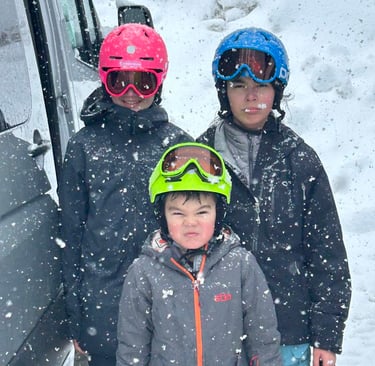Kids and the Law
We’re on winter break. A lot of concentrated time with the kids.


So far they’ve had several near misses on the ski hill, built a luge course that terminates at the base of a large fir tree, started the van on their own and dashed across the street in their ski boots.
That seems like more than enough fodder for a kids and the law newsletter.
Child Injures Child—The Magic of Homeowners Insurance
Kids hurt one another all the time. They shoot each other with BB guns. They aim bottle rockets at their friends. They push and shove climbing ladders to trampolines.
And even though the parents of your kid’s friends didn’t purchase a special policy for pushing and shoving, they did purchase a policy that covers injuries from that kind of behavior. It’s their homeowners policy.
The homeowners policy provides this blanket of coverage for all sorts of things that kids do that can injure one another. (And it also provides what’s called “Med Pay” to help with medical expenses even if people who lived at the home weren’t negligent.)
There’s this idea that kids will be kids. And friends shouldn’t make claims against one another. But that thinking doesn’t help anyone other than the insurance company. Coverage was purchased. Premiums were paid. Who do the parents care more about: your kid or their insurer?
If one of my kids hurt a friend I would demand that our insurance paid whatever it took to compensate the injured kid for what he’d been through.
We’ve recovered a ton of money for people under their friends’ homeowners policies. It’s almost like it’s part of the human condition.
Skier v. Skier Liability
Skiers get hurt in all sorts of different ways. They fall when they’re loading on lifts. They run into things. They suffer twisting injuries in heavy snow. And they run into one another.
Interestingly the Washington legislature made the “Skier Responsibility Code” law. RCW 79A.45.030. In terms of skier v. skier collisions here’s the key language:
Because of the inherent risks in the sport of skiing all persons using the ski hill shall exercise reasonable care for their own safety. However, the primary duty shall be on the person skiing downhill to avoid any collision with any person or object below him or her.
Skier versus skier collisions are covered by homeowners insurance. We’ve settled a number of skier versus skier collision cases and even won one at arbitration.
Comparative Fault and Kids
We have a comparative fault system in Washington. Basically we start with 100 percent of fault. That’s divided up between the person causing the injury and the person who was injured. Sometimes it’s 100 - 0. Sometimes it’s 50 - 50. Sometimes it’s 23 - 77. (You get the picture.)
This applies to kids too. But there are some special rules.
Ordinary care means the same care that a reasonably careful child of the same age, intelligence, maturity, training, and experience would exercise under the same or similar circumstances.
So kids are judged against other kids of the same age. The question isn’t whether adults would appreciate that cars driving on snow might not be able to stop very well. The question is whether kids of the same age, maturity, etc. would appreciate that risk.
Another interesting twist: Kids under six are not capable of comparative fault. So even if a five year old decides to go head first down a sled track built by his neighbors that ends at the base of a fir tree, comparative fault can’t be attributed to him.
Okay. Back to the snow (and super-cold weather).
Myers & Company
Personal Injury Attorneys
© 2024. All rights reserved.


